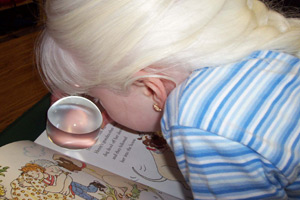Low Vision Devices: An Overview
Children with low vision may benefit from the use of low vision devices to help them see more clearly. These devices include a range of items that are optical and nonoptical.

Optical Devices or Aids
The two most common low vision devices are magnifiers for seeing objects close at hand and telescopes for seeing objects far away. Many children with visual impairments may not realize that fully sighted children and adults use optical devices at times. Many people use magnifiers to read directions printed in very small print or binoculars when they go to sporting events. It’s important for your child to understand that optical devices aren’t just for people with vision loss.
There are differences between the low vision devices your child will use and those you might buy at the store for your own use as a fully sighted person. An eye care professional prescribes low vision devices for individuals with vision loss. Your child’s visual abilities and needs are unique to them, so the low vision devices used by them must be prescribed specifically. Individuals with blindness or low vision have particular needs that a clinical low vision evaluation can determine. An ophthalmologist or optometrist conducts this evaluation, which can identify the devices capable of maximizing your child’s use of vision.
Optical devices or aids use lenses or prisms to magnify, reduce, change the shape or location of an image on the eye’s retina. Optical devices can be held in the hand, rested on a base or stand, or be placed in a pair of eyeglasses. A video magnifier, also known as a closed-circuit television (CCTV). This device is a high-tech low vision device that electronically enlarges materials and projects it onto a monitor.
Cost
The cost of optical devices varies from less than a hundred dollars for some handheld magnifiers to several thousand dollars for typical video magnifiers. If a low vision device has been prescribed for your child, it may be helpful to check with your insurance company to see if optical devices are covered as part of your insurance plan. If your child needs a device that is not provided for home use by the school system or covered by your insurance, you might consider approaching a community service organization to explore whether they can assist in paying for your child’s device.
Near-Vision Optical Devices
Near-vision optical devices are primarily used for tasks within arm’s reach, such as reading, writing, self-help tasks. Examples of these devices include:
- Handheld magnifiers
- Stand magnifiers
- Bar magnifiers
- Illuminated magnifiers
- Mirror magnifiers for putting on makeup or other self-care tasks

If your child is prescribed a magnifier, provide them with opportunities to use it. You might want to show your child how to apply makeup using a mirror with magnification.
Distance-Vision Optical Devices
Optical devices for distance viewing are also referred to as telescopic devices. These include handheld monoculars, clip-on monoculars, spectacle-mounted telescopes, and contact lens systems. Specifically, individuals use these devices for distance tasks beyond arm’s reach. For instance, tasks such as reading content on a classroom whiteboard, identifying street signs, and watching television are made easier with the help of these devices
Some electronic magnification systems allow the user to aim a camera at an object in the distance and view it on a screen. Additionally, these devices allow the user to view near information as well, similar to the way in which video magnifiers work. In the classroom, these devices allow a child to see what the teacher is writing on the board.
Low Vision Driving
Bioptic telescopic systems (BTSs) are specially designed eyeglasses. These eyeglasses allow a person with low vision who meets certain qualifications to drive a vehicle. For some teens, low vision driving may be possible using a BTS.
Nonoptical Devices
Nonoptical devices are aids or devices that a child may use to enhance the efficient use of their vision. They typically control lighting or improve contrast.
Nonoptical devices include:
- Sunglasses
- Hats or visors with brims
- Reading stands
- Dark-lined paper
- Black felt-tipped pens
Instruction in the Use of Optical Devices
Receiving a prescription for optical devices is only the first step in the process of learning to use them efficiently. Training in how to use a device and continued will help your child feel comfortable with a device. Training is typically part of low vision services, which include a clinical low vision examination and follow-up as well. In addition, your child’s teacher of students with visual impairments and orientation and mobility (O&M) instructor are knowledgeable about teaching children to use optical devices. If your child is prescribed a device, Individualized Education Program (IEP) goals for optical device use should be considered by the educational team. In general, your child will be more motivated to learn to use optical devices if there are functional reasons.
It is important to encourage your child to use any prescribed distance-vision optical devices in a variety of environments. The sooner your child receives a prescription for these devices and learns to use them, the more integrated into their life they will become